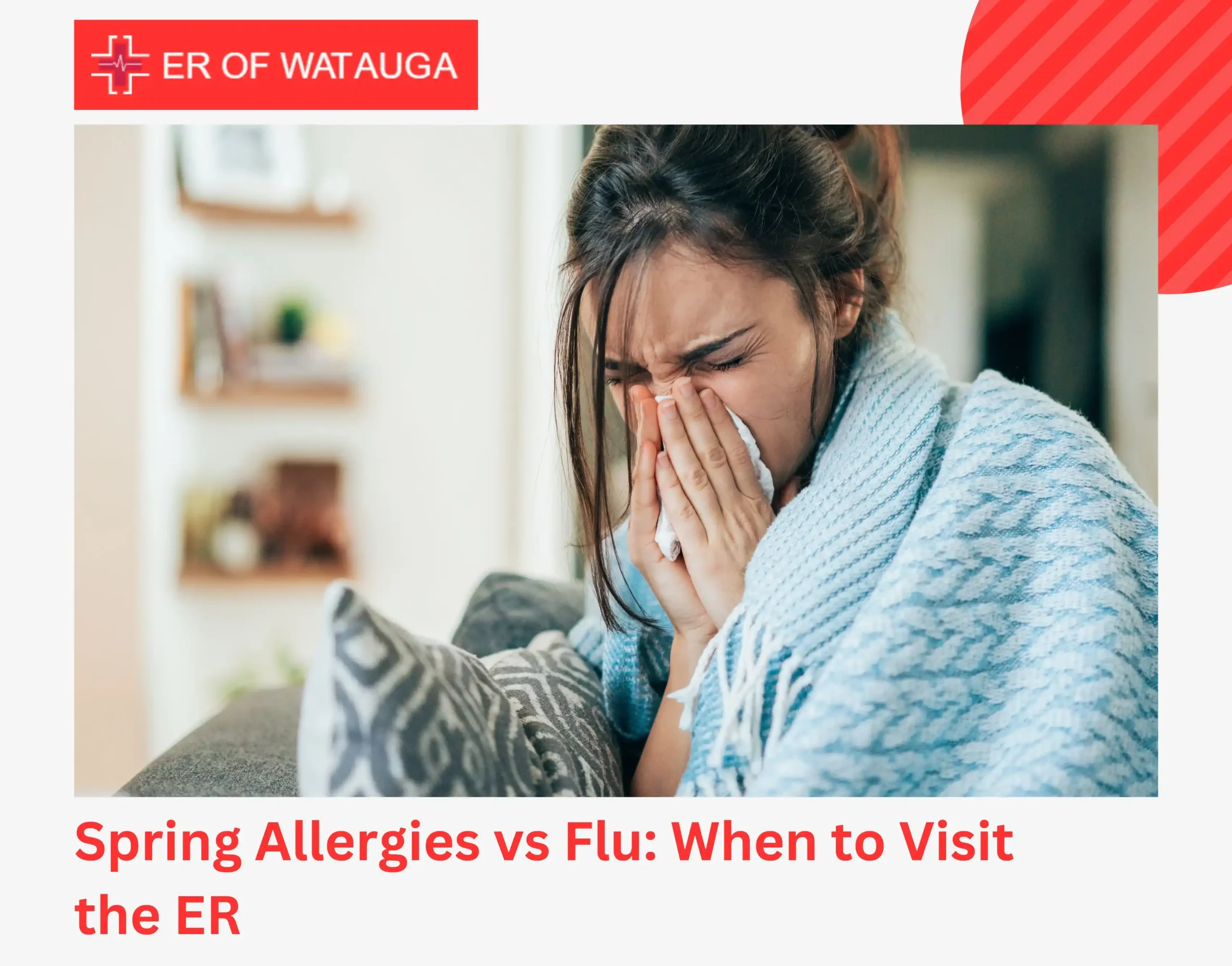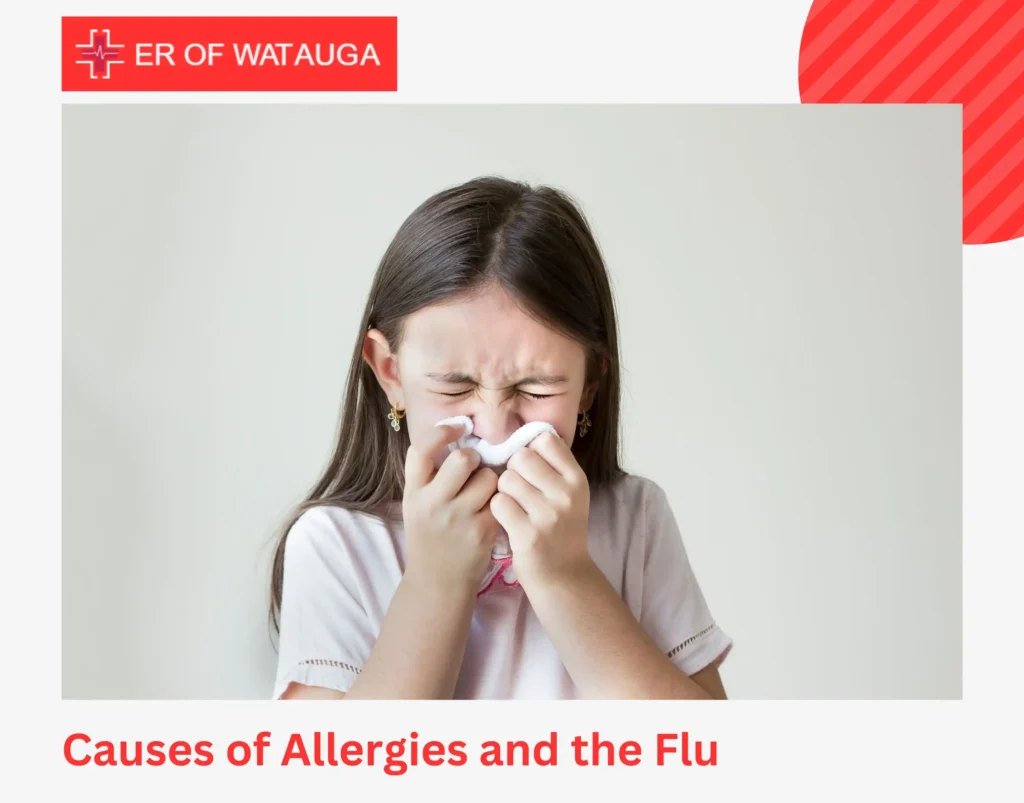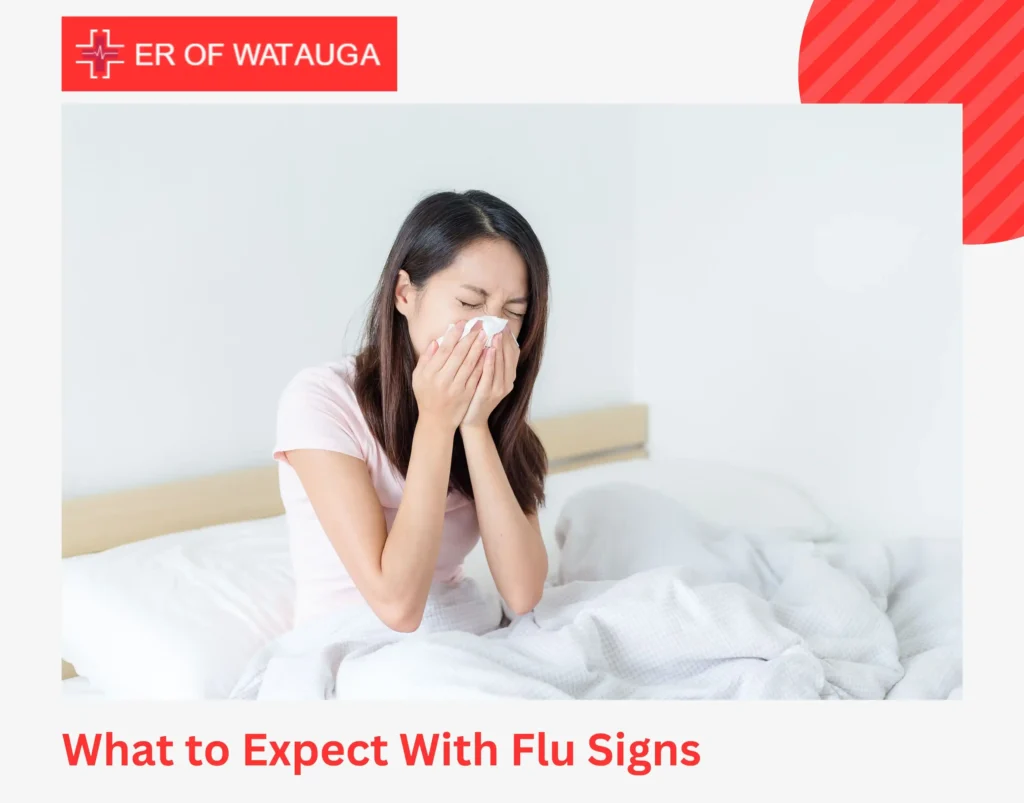Over 80 million Americans battle seasonal allergies annually, yet many mistake flu symptoms for allergic reactions during spring months.¹ The confusion between spring allergies vs flu stems from their shared symptoms. Congestion, coughing, and fatigue appear in both conditions, but there are some critical differences between spring allergies and flu.
Allergies typically bring itchy eyes and clear mucus but rarely fever above 100°F. Flu hits suddenly with high fever, deep muscle pain, and overwhelming exhaustion that allergies simply don’t cause.
Most allergy symptoms respond to over-the-counter remedies, but certain warning signs require emergency care. Breathing difficulty, persistent dizziness, or severe dehydration signal something far beyond allergies that needs immediate medical attention.
Causes of Allergies and the Flu
Spring Allergies
Spring allergies, also known as seasonal allergic rhinitis or “hay fever,” happen when your body mistakes harmless things like pollen for dangerous invaders. Your body reacts by releasing histamines that causes sneezing, watery eyes, and stuffiness.
For millions of Americans with hay fever, spring brings discomfort instead of joy. The main causes of allergies include:
- Pollen from trees like oak, cedar, and maple
- Grass pollen (notably Bermuda, rye, Timothy grass)
- Mold that grows after spring rain
- Pet dander and dust stirred up during spring cleaning
The Flu
The flu (influenza) comes from a virus, not an allergic reaction. When this virus enters your body, it makes you sick by attacking your respiratory system. People spread the flu by coughing, sneezing, or touching surfaces after they’ve touched their nose or mouth.
While flu mainly hits in winter, it often stretches into spring when allergies are also active. This timing can make it hard to tell if your symptoms come from allergies or the flu.
Key Differences Between Spring Allergies vs Flu
Telling apart spring allergies and flu matters because they need different treatments. Here’s how to spot the difference:
- Fever: Flu almost always brings a temperature spike above 100.4°F. Allergies rarely cause fever, so a thermometer can be your first clue.
- Body Pain and Fatigue: The flu typically causes intense body aches, chills, and a sudden wave of fatigue. Allergies might make you tired from poor sleep, but they won’t make your muscles ache.
- Sneezing and Runny Nose: Sneezing is common in both conditions, but it’s usually more frequent and repetitive with allergies. Allergic reactions also tend to produce clear nasal discharge, while the flu may cause yellow or green mucus, often indicating infection.
- Itchy Eyes and Nose: If your eyes and nose itch like crazy, you’re likely dealing with allergies. Flu rarely causes itching.
- Cough Type: Flu-related coughing is persistent and may feel deep in your chest. Allergy coughs tend to be lighter, dry, and results from post-nasal drip.
- Onset and Duration: Flu symptoms come on quickly, often within hours of exposure to the virus, and usually improve within a week with proper care. Allergy symptoms appear gradually and can stick around as long as you’re exposed to triggers.
- Contagiousness: You can catch the flu from others as it’s highly contagious, but no one “catches” allergies from you.
Table: Spring Allergies vs Flu
| Symptom | Spring Allergies | Flu |
| Fever | Rare | Common, 100.4°F+ |
| Body Aches | Minimal to none | Severe |
| Mucus | Clear, watery | Thick, colored |
| Itchiness | Common | Rare |
| Cough | Mild, dry | Painful, persistent |
| Onset | Gradual | Sudden |
| Duration | Weeks to months | 5-7 days |
| Contagious | No | Yes |
A Closer Look at Allergy Symptoms
Allergy symptoms are often tied to environmental exposure. For instance, you may wake up with a stuffy nose and itchy eyes after sleeping with an open window, or symptoms may worsen after mowing the lawn or going for a walk in the park.
Common Spring Allergy Symptoms:
- Itchy, watery, or red eyes
- Sneezing fits
- Clear nasal drainage
- Nasal congestion or stuffy nose
- Itchy throat or ears
- Mild fatigue or brain fog
- Dry, tickly cough
What to Expect With Flu Signs
Flu symptoms tend to appear suddenly. You might feel fine in the morning but develop chills, fever, and body aches by evening. The flu affects the entire body, not just the sinuses or airways, and tends to be more debilitating than allergies.
Common Flu Signs:
- Fever, often over 101°F
- Chills or sweats
- Muscle and joint pain
- Severe headaches
- Dry or wet cough
- Sore throat
- Sudden, intense fatigue
- Nausea, vomiting (in children especially)
The flu can be dangerous for young children, older adults, and individuals with weakened immune systems. Complications like pneumonia, bronchitis, or sinus infections can develop, especially when left untreated.
Managing Spring Allergies
1. Find the Right Medication
Determining whether you have allergy symptoms or flu signs is essential before taking a treatment approach. Antihistamines work well for typical allergy symptoms like sneezing, itchy eyes, and runny nose.
For sinus pressure or headaches, decongestants can help by reducing nasal passage swelling. Talk to a medical professional before using decongestants if you have high blood pressure, as they may raise your blood pressure levels.
2. Start Medications Before Allergy Season Peaks
Don’t wait for symptoms to start, begin the treatment before pollen levels spike. Steroid nasal sprays are most effective when started about two weeks before allergy season begins. If OTC meds aren’t enough, talk to your healthcare provider about stronger prescription options, allergy testing, or allergy shots.
3. Consult Your Pharmacist
While over-the-counter allergy medications are accessible, they can interact with other prescriptions or chronic health conditions. Your pharmacist can help you safely select the right medication and determine whether you’re dealing with spring allergies vs flu. For unclear symptoms or worsening conditions, consult your doctor.
4. Reduce Allergen Exposure Indoors
Create an allergen barrier for your home. Take off your shoes and change clothes after spending time outside. Showering can help remove pollen from your skin and hair. Wipe down pets before they come inside, especially during high pollen days. Keep windows shut and use HEPA filters or air purifiers to keep indoor air clean.
5. Monitor Local Allergy Reports
Use tools like pollen.com to track your local allergy forecast. This helps you time your medication use and plan outdoor activities accordingly.
6. Try a Sinus Rinse
A sinus rinse helps flush allergens and excess mucus from your nasal passages. Allergy-induced mucus buildup can create a perfect environment for bacterial or viral infections. Follow CDC guidelines for proper sinus rinsing technique to safely relieve congestion.
7. Strengthen Your Immune System with a Healthy Diet
Boost your body’s allergen response with nutrient-rich foods. Limit processed and inflammatory items. Focus on fruits and vegetables high in Vitamin C, quercetin, and bromelain. Oranges, apples, pineapple, kale, and blueberries can help regulate immune responses and reduce inflammation.
Also Read: Beating the Flu: Proven Strategies for Recovery
Spring Allergies vs Flu: Family Impact
Is It Contagious? Kids and Household Spread
Spring allergies vs flu create particular challenges for families with multiple children. While allergies aren’t contagious, flu spreads rapidly in household settings.
Monitor these key differences when siblings show symptoms:
- Fever and body aches suggest flu, not allergies
- Itchy eyes and clear mucus point to allergies
- Sudden onset indicates flu; gradual symptoms suggest allergies
- One child improving while another worsens suggests contagious illness, not allergies
Separate utensils, enhance hand hygiene, and improve room ventilation when flu is suspected. Spring allergies alone don’t require these precautions.
Spring Allergy Complications
Spring allergies vs flu complications differ significantly. While flu can lead to respiratory infections, severe allergies can trigger:
- Asthma attacks or bronchospasm
- Sinusitis from prolonged inflammation
- Sleep disturbances leading to fatigue
- Ear infections from eustachian tube dysfunction
These complications require different treatment approaches than flu-related issues. Allergy complications respond to antihistamines and corticosteroids, while flu complications often need antiviral medications or antibiotics for secondary infections.
Warning Signs: When to Get Emergency Help
Spring allergies vs flu emergencies present distinct warning signs:
Allergy Emergencies:
- Sudden breathing difficulty after exposure
- Chest tightness
- Swelling of lips, tongue, or throat
- Severe hives spreading rapidly
- Dizziness with significant blood pressure drop
Flu Emergencies:
- High fever persisting beyond 3-4 days
- Severe dehydration despite fluid intake
- Confusion or altered mental status
- Severe headache or facial pain
- Chest pain or severe productive cough
When to Go to ER for Flu and Spring Allergies
Distinguishing between spring allergies vs flu becomes critical when symptoms intensify beyond what over-the-counter remedies can manage. While most cases resolve with home care, certain warning signs like breathing difficulty, high persistent fever, or severe dehydration indicate a need for emergency evaluation.
At ER Watauga, our physicians provide rapid diagnostic clarity through COVID-19, flu, strep, and mono testing when symptoms become concerning. We deliver IV fluids for dehydration, respiratory support for breathing difficulties, and appropriate medications based on whether you’re experiencing severe spring allergies vs flu complications.
Our emergency care is available 24/7 without appointments or waiting times. Walk in any time to receive the care you need.
FAQs About Spring Allergies vs Flu
1. When should you go to the ER for allergies?
Go if you have trouble breathing, swelling of the face or throat, chest tightness, or a severe allergic reaction (anaphylaxis).
2. How long is too long for allergies?
If symptoms last more than 2–3 weeks without improvement, see a doctor.
3. What color is allergy mucus?
Usually clear; yellow or green may suggest infection.
4. How to clear histamine from the body?
Stay hydrated, follow a low-histamine diet, take antihistamines, and support gut health.
5. Is rice high in histamine?
No, rice, especially plain white or brown rice is considered low in histamine and is generally safe for people with histamine intolerance.
6. What is a histamine dump at night?
A histamine dump is a sudden release of histamine, often during the night, which can cause symptoms like itching, headaches, night sweats, or insomnia. It’s linked to circadian rhythms and mast cell activity peaking at night.
7. Can the ER do anything for allergies?
Yes, ER staff can administer epinephrine for anaphylaxis, provide oxygen, IV fluids, antihistamines, corticosteroids, and monitor your vital signs to prevent complications. It’s the safest place for managing severe allergic reactions.









